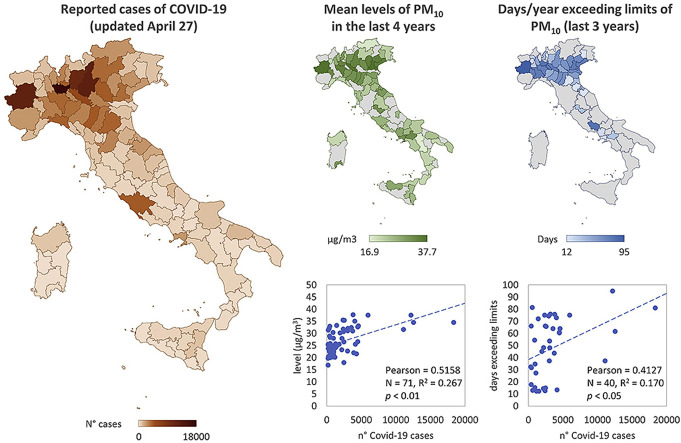- Record: found
- Abstract: found
- Article: not found
Role of the chronic air pollution levels in the Covid-19 outbreak risk in Italy ☆

Read this article at
Abstract
After the initial outbreak in China, the diffusion in Italy of SARS-CoV-2 is exhibiting a clear regional trend with more elevated frequency and severity of cases in Northern areas. Among multiple factors possibly involved in such geographical differences, a role has been hypothesized for atmospheric pollution. We provide additional evidence on the possible influence of air quality, particularly in terms of chronicity of exposure on the spread viral infection in Italian regions. Actual data on Covid-19 outbreak in Italian provinces and corresponding long-term air quality evaluations, were obtained from Italian and European agencies, elaborated and tested for possible interactions. Our elaborations reveal that, beside concentrations, the chronicity of exposure may influence the anomalous variability of SARS-CoV-2 in Italy. Data on distribution of atmospheric pollutants (NO 2, O 3, PM 2.5 and PM 10) in Italian regions during the last 4 years, days exceeding regulatory limits, and years of the last decade (2010–2019) in which the limits have been exceeded for at least 35 days, highlight that Northern Italy has been constantly exposed to chronic air pollution. Long-term air-quality data significantly correlated with cases of Covid-19 in up to 71 Italian provinces (updated April 27, 2020) providing further evidence that chronic exposure to atmospheric contamination may represent a favourable context for the spread of the virus. Pro-inflammatory responses and high incidence of respiratory and cardiac affections are well known, while the capability of this coronavirus to bind particulate matters remains to be established. Atmospheric and environmental pollution should be considered as part of an integrated approach for sustainable development, human health protection and prevention of epidemic spreads but in a long-term and chronic perspective, since adoption of mitigation actions during a viral outbreak could be of limited utility.
Graphical abstract
Highlights
Abstract
Chronic exposure to air pollutants might have a role in the spread of Covid-19 in Italian regions. Diffusion of Covid-19 in 71 Italian provinces correlated with long-term air-quality data.
Related collections
Most cited references24
- Record: found
- Abstract: found
- Article: found
Clinical Characteristics of 138 Hospitalized Patients With 2019 Novel Coronavirus–Infected Pneumonia in Wuhan, China
- Record: found
- Abstract: found
- Article: not found
Epidemiological and clinical characteristics of 99 cases of 2019 novel coronavirus pneumonia in Wuhan, China: a descriptive study
- Record: found
- Abstract: found
- Article: not found

